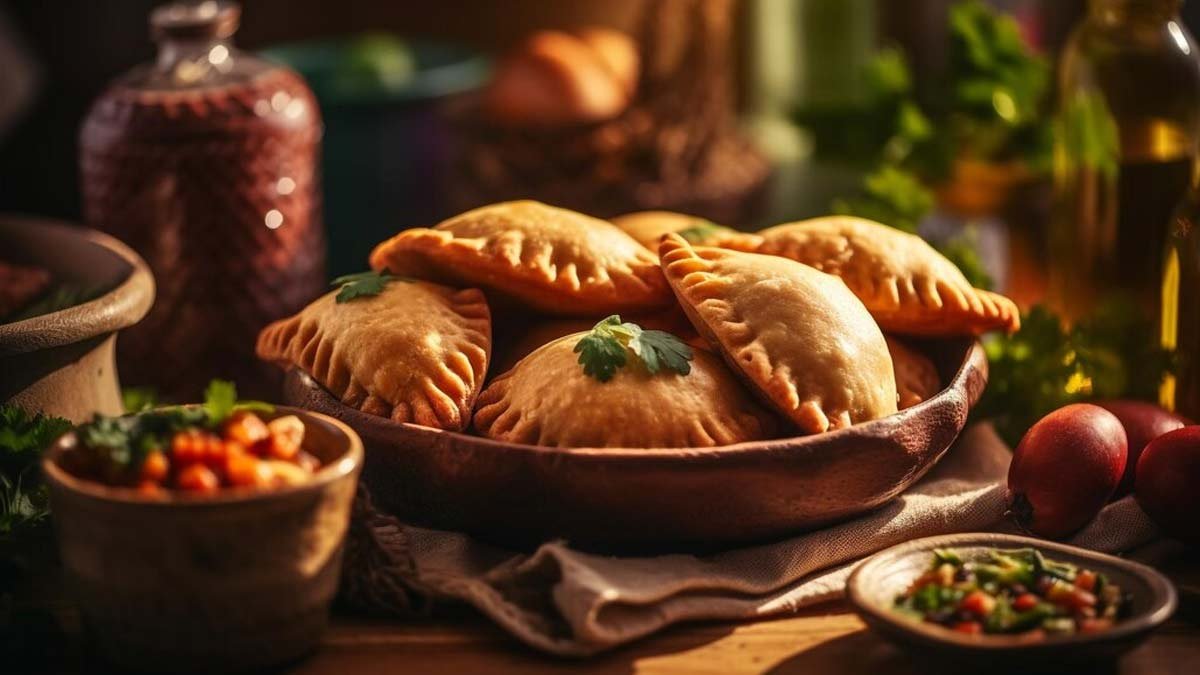Among all Indian culinary treasures, there’s one delicacy that stands out, not just for its delightful taste but also for the joy and festivity it represents – the Gujiya. A symbol of celebration, Gujiya is more than just a sweet treat. It’s a tradition, a memory, a part of our cultural heritage that has been passed down through generations.
It’s the taste of home, of family gatherings, of laughter and love shared over meals. It’s the sweet reward at the end of colorful Holi festivities, and the comforting treat enjoyed on a quiet afternoon.
So, why is Gujiya famous? It’s famous because it’s more than a dish. It’s a celebration of life, love, and the never-ending charm of Indian culinary traditions. It’s the taste of joy, shared across miles, generations, and cultures. And that’s what makes it truly unforgettable.
About Gujiya Recipe
Gujiya is an Indian sweet, often associated with festive celebrations. It’s a half-moon-shaped dessert, made from a delicate pastry filled with a delightful mix of sweetened khoya (condensed milk) and dry fruits, then deep-fried to golden perfection. The result is a deliciously rich treat, crispy on the outside with a soft, sweet filling that melts in your mouth.
Across the diverse landscape of India, Gujiya is known by various names. In Maharashtra, it’s called ‘Karanji’, while in Tamil Nadu, it’s known as ‘Somasi’. In Andhra Pradesh and Telangana, it’s referred to as ‘Kajjikayalu’, and in Gujarat, it’s ‘Ghughra’. Despite the different names, the essence of this sweet remains the same – a beloved treat that brings joy and sweetness to any celebration.
- Preparation Time: 30 Minutes
- Cooking Time: 10 Minutes
- Total Time: 40 minutes
- Servings: 2-3
Nutrition Facts for Gujiya
| Nutrition Facts (Per 1 Pc Serving) | |
| Nutrients | Daily Value (%) |
| Calories | 85 |
| Total fat | 25 gm |
| Sodium | 1780 mg |
| Potassium | 112 mg |
| Total carbohydrates | 12 gm (3%) |
| Dietary fibre | 3 gm (13%) |
| Sugar | 16 gm |
| Protein | 10 gm |
| Calcium | 376 mg |
| Iron | 1 mg |
| Magnesium | 6 mg |
| Phosphorus | 6 mg |
| Zinc | 1 mg |
| Vitamin K | 3µg |
| Vitamin B (Folate) | 6µg |
Ingredients for Gujiya
For Pastry Dough
- 1 cup all-purpose flour (Maida)
- 1 cup whole wheat flour
- ¼ tsp salt
- ⅓ to ½ cup water
- 2 tbsp Ghee
For Sweet Stuffing
- 1 cup Khoya
- ½ tablespoon Ghee
- 8 almonds
- 8 cashews
- 8 pistachios
- ½ tablespoon raisins
- ⅓ cup powdered sugar
- ½ teaspoon green cardamom powder or 6 to 7 green cardamoms powdered in a mortar
- oil as required for deep frying
How to Make Gujiya? Step-by-step Instructions
Here’s a step-by-step recipe for making delicious Gujiya quickly –
Step 1: Making the Dough
- Begin by combining the all-purpose flour, whole wheat flour, and a pinch of salt in a bowl.
- Warm up some ghee until it melts and pour it over the flours. Initially, stir the ghee into the flour with a spoon. Then, use your fingertips to rub the ghee into the flour.
- Gradually add water and start kneading. The quantity of water required will depend on the flour’s texture. Knead until the dough is firm and smooth.
- Cover the dough with a damp cloth and let it rest for 30 minutes.
Step 2: Preparing The Sweet Filling
- Start by crumbling or grating the khoya (Mawa). Set aside the chopped nuts and raisins.
- In a pan, melt some ghee over low heat. Add the crumbled or grated khoya to the pan.
- Continuously stir the khoya over low heat. Cook the khoya until it starts to come together.
- Turn off the heat and let the pan cool on the kitchen counter.
- Once the khoya mixture has cooled completely, add powdered sugar, chopped nuts, raisins, and cardamom powder.
- Combine everything well and set the filling aside. Taste the mixture and add more sugar if needed.
Step 3: Molding
- Split the dough into two portions. Shape each portion into a medium-sized log and cut it into equal pieces.
- Roll each piece into a ball and place all the balls in the same bowl. Cover them with a damp kitchen towel.
- Lightly dust the rolling board with some flour. Roll each ball into a small circle about 4 to 5 inches in diameter.
- Using your fingertip or a pastry brush, moisten the entire edge of the circle. Place about 1 to 1.5 tablespoons of the prepared khoya filling on one side of the circle, leaving the edges clear.
- Be careful not to overfill as it can make shaping the gujiya difficult and they may break when frying.
- Carefully bring the edges together and seal them by pressing gently. Continue folding and twisting the edges until you reach the end.
Step 4: Frying Gujiyas
- Heat oil for deep-frying in a wok or deep pan. Before you start frying, it’s crucial to check the oil’s temperature. Drop a tiny piece of dough into the oil. If it rises slowly and steadily, the oil is at the perfect temperature.
- Carefully slide the Gujiya into the oil, ensuring not to add too many at once to avoid overcrowding.
- Flip them gently to fry the other side. Continue deep-frying until they turn a beautiful golden color, flipping as necessary.
- Once fried, transfer them onto paper towels to drain excess oil. Repeat this process with all the Gujiya. After they’ve cooled down completely at room temperature, store them in an airtight container.
Gujiya Recipe in Hindi (गुझिया कैसे बनाये?)
यह एक स्टेप-दर-स्टेप रेसिपी है जिससे आप तेजी से स्वादिष्ट गुजिया बना सकते हैं –
स्टेप 1: आटा बनाना
- सबसे पहले एक कटोरी में मैदा, गेहूं का आटा और चुटकी भर नमक को मिलाएं।
- थोड़ा घी गर्म करें जब तक वह पिघल न जाए और इसे आटे पर डालें। पहले घी को आटे में चम्मच से मिलाएं। फिर, अपनी उंगलियों का उपयोग करके घी को आटे में घुसाएं।
- धीरे-धीरे पानी डालें और गूंदना शुरू करें। पानी की मात्रा आटे की बनावट पर निर्भर करेगी। गूंदें जब तक आटा कठोर और चिकना न हो जाए।
- आटे को गीले कपड़े से ढकें और इसे 30 मिनट तक आराम करने दें।
स्टेप 2: मीठा भरवां तैयार करना
- खोया (मावा) को तोड़ दें या कस लें। कटे हुए नट्स और किशमिश को अलग रखें।
- एक पैन में, कम आंच पर थोड़ा घी पिघलाएं। पैन में तोड़े हुए या कसे हुए खोया को डालें।
- निरंतर खोया को कम आंच पर हिलाते रहें। खोया पकाएं जब तक वह एक साथ न आ जाए।
- आंच बंद कर दें और पैन को रसोई गैलरी पर ठंडा होने दें।
- जब खोया मिश्रण पूरी तरह से ठंडा हो जाए, तो पाउडर चीनी, कटे हुए नट्स, किशमिश, और इलायची पाउडर डालें।
- सब कुछ अच्छी तरह से मिलाएं और भरवां को अलग रखें। मिश्रण का स्वाद चखें और यदि आवश्यक हो तो और चीनी डालें।
स्टेप 3: मोल्डिंग
- आटे को दो हिस्सों में विभाजित करें। प्रत्येक हिस्से को मध्यम आकार की लॉग में आकार दें और इसे समान टुकड़ों में काट दें।
- प्रत्येक टुकड़े को गेंद बनाएं और सभी गेंदों को एक ही कटोरी में रखें। उन्हें गीले रसोई तौलिए से ढकें।
- रोलिंग बोर्ड को थोड़े से आटे से धूल दें। प्रत्येक गेंद को एक छोटे से वृत्त में बेलें, जिसका व्यास 4 से 5 इंच हो।
- अपनी उंगली या पेस्ट्री ब्रश का उपयोग करके, वृत्त के पूरे किनारे को गीला करें। वृत्त की एक ओर, किनारों को छोड़कर, तैयार खोया भरवां लगाएं।
- ध्यान दें कि अधिक न भरें क्योंकि इससे गुजिया को आकार देना कठिन हो सकता है और वे तलने के समय टूट सकते हैं।
- सावधानीपूर्वक किनारों को एक साथ लाएं और उन्हें हल्के हाथ से दबाकर सील करें। आप अंत तक पहुंचने तक किनारों को लपेटते और मोड़ते रहें।
स्टेप 4: गुजिया तलना
- एक कड़ाही या गहरे पैन में तलने के लिए तेल गरम करें। इससे पहले कि आप तलना शुरू करें, तेल का तापमान जांचना महत्वपूर्ण है।
- गुजिया को सावधानी से तेल में डालें, सुनिश्चित करें कि एक बार में बहुत सारी गुजिया न डालें।
- इन्हें दूसरी तरफ से तलने के लिए धीरे से पलट दीजिए. जब तक वे सुंदर सुनहरे रंग के न हो जाएं, तब तक डीप फ्राई करना जारी रखें, आवश्यकतानुसार पलटते रहें।
- एक बार तलने के बाद, अतिरिक्त तेल निकालने के लिए उन्हें कागज़ के तौलिये पर रखें। इस प्रक्रिया को सभी गुझिया के साथ दोहराएँ। कमरे के तापमान पर पूरी तरह से ठंडा होने के बाद, उन्हें एक एयरटाइट कंटेनर में स्टोर करें।
Serving Suggestions for Gujiya
Gujiya, like most Indian sweets, is typically enjoyed on its own. However, if you’re in the mood for something extra special, consider pairing the Mawa-filled Gujiya with some Rabri, a traditional dessert made from thickened sweetened milk.
Tips and Variations for Gujiya Recipe
- Once the Gujiya has cooled down to room temperature, promptly store them in an airtight container. They will remain fresh for several hours at room temperature.
- Given that the filling is prepared with milk solids, it’s advisable to refrigerate any remaining Gujiya. They should keep well in the fridge for about 1 to 2 days. Enjoy!
FAQs
What Is Gujiya Made Of?
Gujiya is a deep-fried dumpling made from all-purpose flour and filled with a sweet mixture of mawa (milk solids), dry fruits, coconut, and sugar.
What Do You Call Gujiya In English?
Gujiya is often referred to as an “Indian stuffed sweet pastry” in English.
In Which City Gujiya Is Famous?
Gujiya is particularly popular in the Uttar Pradesh, Rajasthan, Gujarat, and Bihar regions of India. It’s also associated with the city of Vrindavan.
Who Invented Gujiya?
The origin of Gujiya is not clear, but it’s believed to have been derived from Turkey’s Baklava, a sweet dessert, dating back to the 13th century.
Can I Eat Gujiya During Weight Loss?
Traditional Gujiya, being high in sugar and deep-fried, may not be suitable for a weight loss diet. However, healthier versions, like baked Gujiya, can be consumed.
Is Gujiya Good For Health?
Traditional Gujiya may not be the healthiest option due to its high sugar and deep-fried nature. However, it does offer some nutrients from nuts and milk solids in the filling.
How Many Calories In A Coconut Gujiya?
An average serving of coconut Gujiya of 100 gm contains about 270 calories.
Tags: Gujiya

